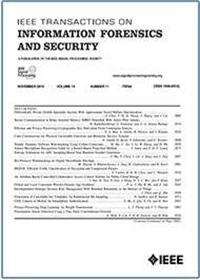Angle and Distance Discrimination by Utilizing Frequency Conversion Capability of STC-IRS for Covert Communications
IF 6.3
1区 计算机科学
Q1 COMPUTER SCIENCE, THEORY & METHODS
IEEE Transactions on Information Forensics and Security
Pub Date : 2025-01-20
DOI:10.1109/TIFS.2025.3530689
引用次数: 0
Abstract
Covert communication is an important approach to ensure information security by hiding the transmission behavior. Space-domain-coding intelligent reflecting surface (SDC-IRS) can adjust the phase of the reflection signal for passive beamforming in angle domains, which is widely employed in covert communications. However, the gains by SDC-IRS vanish when the warder is proximal to the receiver in angle domains. To overcome this limitation, in this paper, the space-time-coding IRS (STC-IRS) is considered, which can adjust both the phase and the frequency of the reflection signal for passive beamforming in angle-distance domains. Specifically, system performance under STC-IRS and SDC-IRS is compared, revealing the essence that angle and distance discrimination for the receiver is achieved with STC-IRS. Further, to fully exploit STC-IRS, optimization problems are formulated to maximize the covert rate in both line-of-sight scenarios and Rician fading scenarios. To solve the above problems, penalty-based algorithms are proposed where the transmit power, the phase shift and the frequency shift at STC-IRS are optimized jointly with majorization-minimization and block successive upper bound minimization techniques. Considering more general and adverse cases, the proposed algorithms are also extended to the scenario with multiple warders. Simulation results demonstrate the superiority of the proposed scheme compared with other benchmarks. Especially, when the warder and the receiver overlap in angle domains, covert rates with STC-IRS exceed 3 bps by distance domain discrimination, whereas covert rates with SDC-IRS are less than 0.01 bps.利用STC-IRS的变频能力进行隐蔽通信的角度和距离识别
本文章由计算机程序翻译,如有差异,请以英文原文为准。
求助全文
约1分钟内获得全文
求助全文
来源期刊

IEEE Transactions on Information Forensics and Security
工程技术-工程:电子与电气
CiteScore
14.40
自引率
7.40%
发文量
234
审稿时长
6.5 months
期刊介绍:
The IEEE Transactions on Information Forensics and Security covers the sciences, technologies, and applications relating to information forensics, information security, biometrics, surveillance and systems applications that incorporate these features
 求助内容:
求助内容: 应助结果提醒方式:
应助结果提醒方式:


